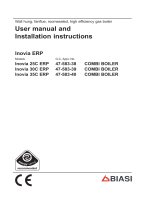1
GENERAL RULES
This instruction book is an integral and essential part of our product and it is delivered together with our boiler.
Read carefully the information about safety, installation and maintenance that are shown in it. The boiler installation is to be carried
out by qualified Corgi Registered Engineer.
IMPORTANT: this boiler is designed to warm water at a lower temperature than 100 deg C at an atmospheric pressure; it has to be
installed to a heating system and to a water supply system suitable for its capacity and duty.
This boiler to be used for the purposed it was designed for . Every other kind of use, has to be considered improper and
dangerous. The manufacter is not to be considered responsible for possible damages caused by any, improper and unreasonable
use.-Isolate the boiler from its supply before doing any kind of service operation.
Do not obstruct boiler aspiration or dissipation grills.
Isolate the boiler if there is any damage or malfunctioning. All repairs must be carried out by an authorized service operation
centre, such as British gas or CORGI registered personnel , using only original approved spare parts.
In order to achieve the highest boiler efficiency and for its correct functioning it is important to follow the manufacturers instructions.
If you decide not to use the boiler for any considerable time, it is advisable to isolate any gas and water connections.
Don't wet the boiler with water or with other liquid substances.
Don't put other items on the surface of the heater.
Before starting every kind of service operation which forces the burner dismantling or the opening of inspection holes you have to
isolate electrical and gas supply.
If there are any chimney service operations turn the boiler off. After having finished the operation you should call your qualified
personnel and check the status of safety valves.
Do not clean the heater with inflammable substances.
Do leave or store inflammable substances near the boiler.(paper, paints ,thinners etc.)
The electrical safety of the heater is assured only if it is correctly earthed.
Your engineer must control the state of the wiring; if there are any problems the manufacturer is not responsible for damages
caused by a non correct earth installation.
Ensure your electrical supply capacity is adequate for the boiler with regards to the elecrical supply to the boiler you cannot use
adapters, multiple plugs and extensions. The use of electrical items implies the careful observation of fundamental rules such as:
1 Do not touch the boiler with wet hands; 2 Do not tear electrical cables;3 Do not allow children or to use the heater.
All maintenance operations and replacement parts must be done using only original spare parts.
Use only flue gas ducts and electric accessories that have been supplied by Manufacturer
Make sure that the drain is properly connected. The manufacturer is not responsible of any food contamination due to incorrect
installation of safety valves and condensate drain. No pipes have should be used as earth .
Please ensure:
1 The correct functioning of the gas inlet system;
2 The correct gas capacity is the one required by the boiler power;
3 That the type of gas used is that the heater was designed for.
4 That the gas supply pressure is within the required values of the heater.
5 That the gas inlet system is correct and has all the required safety features which are required by law.
If You smell gas Do not turn electrical switches on. Open all windows and doors, extinguish any naked flames, close all gas
cocks and call your gas supply company.
Note: due to the high efficiency of the boilers a plume of steam will form at the flue outlet during the operation.
It is UK law that the fitting of the appliance and any controls to the appliance may only be carried out by a competent engineer in
accordance with the Gas Safety (installation and use) regulations 1998.
Flue systems must not be modified in any way other than as described in the fitting instructions. Any misuse or unauthorized
modifications to the appliance, flue or associated components and systems could invalidate the warranty. The manufacturer
accepts no responsibility arising from any such actions, excluding statutory rights.
All gas appliances must be installed by competent qualified engineer, CORGI-certified personnel in accordance with the following
recommendations:
Gas Safety Standards (Installation and Use) Regulations 1994 (as amended).
All relevant Building Regulations issued by the Department of the Environment.
Building Standards (Scotland)(Consolidation) Regulations issued by the Scottish Development Department.
Model and local Water Undertaking Byelaws.
Current IEE Wiring Regulations and IEE Earthing Regulations.
Health and Safety Document No. 635 “Electricity Standards in the Workplace 1989”
The Installation should also be in accordance with the following British Standard Codes of Practice:
BS 5540:1:1990 Flues
BS 5540:2:1989 Air supply
BS 5449: 1990 Forced circulation of hot water systems
BS 5546: 1990 Installation of hot water supplies for domestic purposes
BS 6700: 1987 Design, installation, testing and maintenance of services supplying water
BS 6798:1987 Installation of gas fired hot water boilers
BS 6891:1989 Gas installation
BS 7593:1992 Code of practice for treatment of water in heating systems
Failure to install appliances correctly could lead to prosecution. It is in your interest and that of safety to ensure that the law is
complied with. Important the Benchmark logbook must be completed by the installer and must include his CORGI registration
number to confirm that the boiler has been installed, commissioned, and serviced in accordance with the manufacture’s
instructions.
Important ; The completed benchmark Log Book will be required in the event of any request for warranty work and may also be
required by the local Building control Inspector.
























